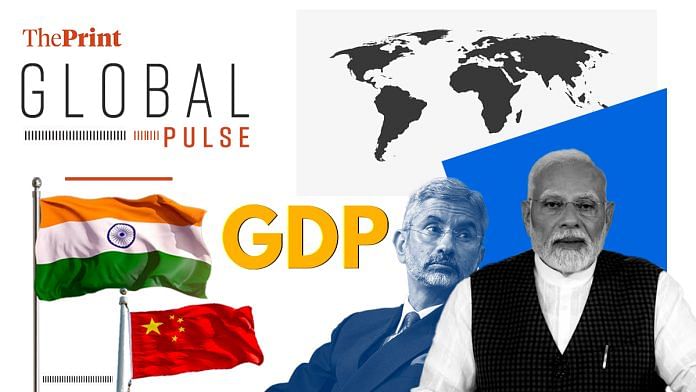New Delhi: The Indian government is flexing a new muscle to compete with China in the great geopolitical game: its fast-growing economy, according to the New York Times.
India’s economic potential is its “newfound leverage”, the story says, especially as it faces “diplomatic setbacks” in the subcontinent—“over the past year, India-friendly leaders in at least three countries were either voted out or toppled in protests”. Offset by an aggressive Chinese push in the region, this would usually spell trouble if it weren’t for India’s economic clout. Even those leaders traditionally stereotyped as “anti-India” have no choice but to work with New Delhi.
“Many poorer Indians have seen little benefit from that growth, as the country still struggles to generate enough employment. But it has provided the government with much-needed cash to grease diplomatic wheels, while China’s economic struggles have forced it to somewhat reduce its regional largess,” the story says.
It points to the recent examples of Bangladesh and Sri Lanka. The ousting of Sheikh Hasina and her subsequent flight to India presented a diplomatic dilemma for New Delhi—on one hand, they had been supportive of Hasina, which led to a massive wave of “anti-India” sentiments in Bangladesh, and on the other, they had to establish good relations with the new government. This has led to the tacit need for a more “pragmatic” approach in Indian foreign policy, a departure from past “histrionics” and “diplomatic theatre”, according to the NYT.
In the case of Sri Lanka, India rushed to fill a China-sized hole in the form of $4 billion financial aid after its economic crisis. When it elected a new president, the Indian High Commissioner met him before the Chinese Ambassador did.
The story ends with a quote from former diplomat Nirupama Menon Rao. “China continues to flex a lot of economic muscle, there’s no doubt,” Rao says to NYT. “But China, I think, has not really demonstrated its capacity to be the kind of first responder that India is when it comes to crisis situations that face our neighbors. And that, I think, is a very critical factor.”
Another global publication, however, diverges from NYT’s take on India’s economic prowess. While Modi says the world is living through an “Indian era”, The Economist says that the Indian economy “seems to be losing momentum”. Quoting recent data, it says that the latest annual GDP growth rate is the slowest expansion in over a year.
“Data released in the past fortnight suggest that the slowdown has continued. An index tracking output in eight core industries, such as coal, oil and electricity, fell in August for the first time in more than three years,” the story says, also quoting a drop in car sales and GST collections.
The Indian government can continue asserting that the Indian growth story is intact, but numbers don’t lie. The finance ministry dismissed these numbers as “incipient signs of strains”. The Economist quotes Jairam Ramesh’s warning of the “three dark clouds” that loom over the economy: “weak private investment, stagnant manufacturing and falling real wages”.
The Economist pokes another hole in the Indian imagination: The political establishment’s reliance on exit polls.
“Pity India’s pollsters,” the piece opens. “They have never been much good at predicting election results.”
Analysing the recent elections in Haryana and Jammu and Kashmir, the publication draws three conclusions: First, the BJP is effective despite the general elections, that Congress is comparatively still ineffective despite its recent electoral performances, and—far more significantly—that these results might be good for the BJP, but bad for Modi.
The Economist says that Modi’s “party appears to be growing less dependent on him to win votes”. He only held four rallies in Haryana—down from his 10 rallies in 2014 and six in 2019—and BJP candidates this time around focused on local issues rather than playing up the Modi factor.
“That could spell trouble for him if rivals in the BJP launch a leadership bid in the future,” the story observes.
The next test of his popularity will be in Maharashtra, which goes to polls at the end of November. Its outcome will determine the BJP’s electoral comeback. “The race will be tight, according to polls,” the story ends. “But don’t bet on it.”
Meanwhile, the South China Morning Post wonders if External Affairs Minister S. Jaishankar’s visit to Pakistan—scheduled for later this month—will break the ice between India and Pakistan.
It’s the first such visit in a decade, and it looks like SCMP doesn’t have very high hopes for a thawing of bilateral ties. “While the visit has raised hopes for improving ties between the two countries, experts emphasise that it is merely a routine engagement in a multilateral setting,” it says, adding that the visit should be “seen through the lens of the SCO and not of India-Pakistan relations”.
The Shanghai Cooperation Organisation (SCO) includes China, Russia, India, Pakistan, Iran, Kazakhstan, Kyrgyzstan, Tajikistan, Belarus and Uzbekistan, and the 2024 summit is being hosted in Pakistan. The story quotes Michael Kugelman, director of the Wilson Center’s South Asia Institute, as saying Jaishankar would probably not have come had it been 2020 or 2019. “One reason for Jaishankar’s visit was because the climate between the two countries had since become sufficiently stable,” the story says.
The last such high-level meeting was in 2016, when then-home minister Rajnah Singh attended the SAARC meeting in Pakistan. In 2015, Modi surprised global media by meeting Nawaz Sharif while he was in Lahore for his granddaughter’s wedding.
The story quotes former Indian ambassador to Pakistan Ajay Bisaria, however, as saying that the SCO participation is an opportunity to improve ties with Pakistan: “What India is doing, by sending a minister, is sending a signal that we want to stabilise the relationship,” he said.
(Edited by Zinnia Ray Chaudhuri)
Also read: Global media on how India is cooling—the homes of its own people & towards its neighbour Pakistan






